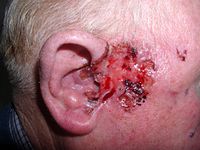
Photo from wikipedia
Background Ambient nitrogen dioxide (NO 2 ) is a common air pollutant in developing countries and causes skin conditions, but its effect on eczema in subtropical areas is not clear… Click to show full abstract
Background Ambient nitrogen dioxide (NO 2 ) is a common air pollutant in developing countries and causes skin conditions, but its effect on eczema in subtropical areas is not clear in China. Object To measure the effect of short-term exposure of NO 2 on the incidence of eczema and the change of outpatient visits. Methods Data of daily temperature, air pollutants, and outpatient visits from 2013 to 2018 were collected in a row. The generalized additive model (GAM) and Poisson distribution were used to assess the association between short-term exposure of NO 2 and the outpatient visits of patients with eczema. The cumulative exposure effect of lag 0–3 days and the displacement effect of NO 2 and other pollutants were considered as well. A single pollutant model was used to examine the independent association, and a two-pollutant model was adopted to control the confounding effect. Results The daily outpatient visits of eczema increased from 75.26 to 190.85 from 2013 to 2018 ( P < 0.001). The combined influence of NO 2 and the related pollutant exerted a stronger influence on the incidence of eczema. The maximum effect of NO 2 appeared on the exposed day. (lag 0) and disappeared on day 4 (lag 3). The children and seniors were more vulnerable to NO 2 exposure. Conclusion Exposure to NO 2 is tightly associated with eczema incidence and outpatient visits. The hospitals should react to the visit fluctuations and adjust physician duty shifts to improve outpatient service efficiency.
Journal Title: BMC Public Health
Year Published: 2021
Link to full text (if available)
Share on Social Media: Sign Up to like & get
recommendations!